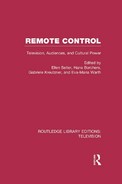Book Description
The ways in which we watch television tell us much about our views of gender, the family and society. Bringing together the leading experts in the field of audience studies, this book investigates how viewers watch television, and what they think about the programmes they see. Originally published in 1989, the book is divided into two sections which discuss some of the theoretical issues at stake and then present case studies of a wide range of viewers: women office workers, Israeli watchers of Dallas, German families, the elderly, and American daytime soap fans. Contributors from Britain, the United States, Western Europe, Australia and Israel offer a wide range of perspectives, from feminism to post-modernism, and from semiotics to Marxism.
‘Together these essays constitute one of the best possible introductions to the leading edge of research into the phenomenon of television.’ Choice
Table of Contents
- Cover
- Half Title
- Title Page
- Copyright Page
- Original Title Page
- Original Copyright Page
- Table of Contents
- Preface
- Introduction
- 1 Changing paradigms in audience studies
- 2 Bursting bubbles: “Soap Opera,” audiences, and the limits of genre
- 3 Moments of television: Neither the text nor the audience
- 4 Live television and its audiences: Challenges of media reality
- 5 Wanted: Audiences. On the politics of empirical audience studies
- 6 Text and audience
- 7 Out of the mainstream: Sexual minorities and the mass media
- 8 Soap operas at work
- 9 The media in everyday family life: Some biographical and typological aspects
- 10 Approaching the audience: The elderly
- 11 On the critical abilities of television viewers
- 12 “Don't treat us like we're so stupid and naïve”: Towards an ethnography of soap opera viewers
- Select bibliography
- Index
